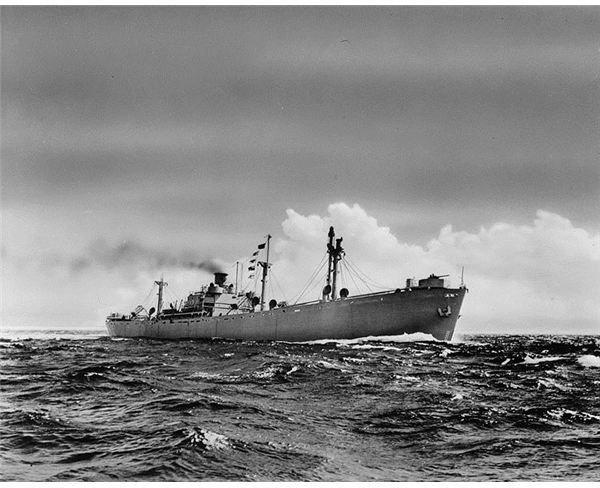History of the Liberty Ships from World War 2: The Fatally Flawed Ships
The Liberty ships were a so-called “emergency” class of ships developed during World War II. Described variously as “dreadful looking” and an “ugly duckling,” the Liberty class of ships nonetheless came to represent the immense industrial might of the United States early on in the war effort. Nearly 3000 of the ships were built in an extremely short period; the first ship was built in just 70 days. The short timescale from design to construction, however, led to the inclusion of several fatal flaws in the ship design, and many ships were lost due brittle steel failures.
Image: Wikimedia Commons - Liberty Ship at Sea
Design of the Liberty Class
The Liberty class was designed to fill a void in merchant marine ships as the United States rapidly ramped up its war effort. They were given the designation “EC2-S-C1,” the EC standing for emergency cargo. The ships were designed to minimize labor and material costs; this was done in part by replacing many rivets with welds. This was a new technique, so workers were inexperienced and engineers had little data to go on. Additionally, much of the shipyards’ labor force had been replaced with women as men joined the armed forces. Because of this, early ships took quite a long time to build - the Patrick Henry taking 244 days - but the average building time eventually came down to just 42 days.
The Liberty ship model used two oil boilers and was propelled by a single-screw steam engine, which gave the liberty ship a cruise speed of 11 to 11.5 knots. The ships were 441.5 feet long, with a 57 foot beam and a 28 foot draft. They were staffed by a full crew of about 44 men, plus 12 to 25 national guardsmen. The armament was a 4 or 5 inch stern gun, a 3 inch bow gun, two 37 mm bow guns, and six 20 mm machine guns.
Liberty Ship Design Flaws
Many early Liberty ships were affected by deck and hull cracks and indeed several were lost. About 1,200 ships suffered from cracks during the war (about 30% of all Liberty-class ships), and 3 were lost when the ship suddenly split in two. Though the work force was largely untrained in the method of welding ships together, it was not worker error that caused these failures. Rather, the failures were caused by a design oversight.
The cause of the failures was discovered by Constance Tipper, an engineering professor at Cambridge. She found that the grade of steel used to make Liberty ships suffered from embrittlement, in which materials become brittle. Ships operating in the North Atlantic were often exposed to temperatures below a critical temperature, which changed the failure mechanism from ductile to brittle. Because the hulls were welded together, the cracks could propagate across very large distances; this would not have been possible in riveted ships.
A crack stress concentrator contributed to many of the failures. Many of the cracks were nucleated at an edge where a weld was positioned next to a hatch; the edge of the crack and the weld itself both acted as crack concentrators. Also contributing to failures was heavy overloading of the ships, which increased the stress on the hull. Engineers applied several reinforcements to the ship hulls to arrest crack propagation and initiation problems.
Post-War use of the Liberty Ships
A total of 2,710 Liberty ships were built, with an expected lifespan of just five years. A little more than 2,400 made it through the war, and 835 of these entered the US cargo fleet. Many others entered Greek and Italian fleets. Many of these ships were destroyed by leftover mines, which had been forgotten or inadequately cleared. Two ships survive today, both operating as museum ships. They are still seaworthy, and one (the Jeremiah O’Brien) sailed from San Francisco to England in 1994.
Sources
Liberty Ships built by the United States Maritime Commission in World War II
Fracture - Some Maritime Examples
The Yard that Built Liberty Ships
